
Best Workforce Planning Software for SMBs
Compare top workforce planning tools that help SMBs cut scheduling time by 75% and make smarter hiring decisions with predictive analytics.

Written by
Adam Stewart
Key Points
- Match software features to your industry (POS integration for restaurants)
- Choose tools that work with your existing systems like QuickBooks
- Use predictive analytics to forecast staffing needs 3-6 months ahead
- Start with scalable solutions that grow from 50 to 500+ employees
Managing a workforce can be tough for small and medium businesses (SMBs). But workforce planning software can simplify tasks like scheduling, tracking performance, and staying compliant with labor laws. These tools save time, cut costs, and improve employee satisfaction. Here's a quick look at 10 top workforce planning platforms tailored for SMBs:
- Agentnoon: Focuses on long-term workforce forecasting with scenario planning and predictive analytics. Integrates with tools like BambooHR and QuickBooks.
- BambooHR: Combines HR management with workforce planning, offering people analytics and seamless integrations.
- Rippling: Merges HR, IT, and finance functions, with detailed cost forecasting and compliance tools.
- Drivetrain: Financial-first workforce planning, linking hiring decisions to revenue and profitability.
- Homebase: Designed for retail and service businesses, automates scheduling and tracks labor costs.
- 7shifts: Tailored for restaurants, predicts staffing needs using sales forecasts and integrates with POS systems.
- Paymo: Ideal for project-based businesses, helps with resource allocation and team schedules.
- Teamhood: Combines project management with workforce planning, integrates with tools like Slack and Microsoft Teams.
- tamigo: Centralizes workforce management, with a focus on integration and multi-location support.
- ChartHop: Visualizes team structures and links workforce costs to budgets for better planning.
These platforms cater to different industries and business sizes. The right choice depends on your specific needs, such as forecasting, integrations, or scalability.
Quick Comparison:
| Software | Best For | Key Features | Integration Examples | Scalability Focus |
|---|---|---|---|---|
| Agentnoon | Long-term planning | Scenario modeling, predictive analytics | BambooHR, Gusto, QuickBooks | 50–500 employees |
| BambooHR | HR + workforce planning | People analytics, customizable reports | Payroll, project management | Modular design |
| Rippling | HR, IT, and finance combo | Total cost forecasting, compliance automation | QuickBooks, Slack, Google | Multi-state/international |
| Drivetrain | Financial-first planning | Revenue impact analysis, seasonal planning | Salesforce, HubSpot, QuickBooks | Multi-location modeling |
| Homebase | Retail/service businesses | Automated scheduling, labor cost tracking | QuickBooks, Square, Gusto | Multi-location simplicity |
| 7shifts | Restaurants | Sales-based staffing, POS integrations | Toast, Square, ADP | Multi-location flexibility |
| Paymo | Project-based businesses | Resource allocation, Gantt charts | QuickBooks, Slack, HubSpot | Unlimited projects/clients |
| Teamhood | Project management + teams | Task creation, bidirectional syncing | Slack, Microsoft Teams, Zapier | Advanced API for scaling |
| tamigo | Workforce centralization | Open API, employee data sync | HR/payroll systems, POS tools | International-ready |
| ChartHop | Visual workforce planning | Org charts, compensation tracking | HRIS, financial tools | Team structure adaptability |
Choose software based on your business size, industry, and growth plans. Many platforms offer free trials - test them to see what works best for your team.
1. Agentnoon
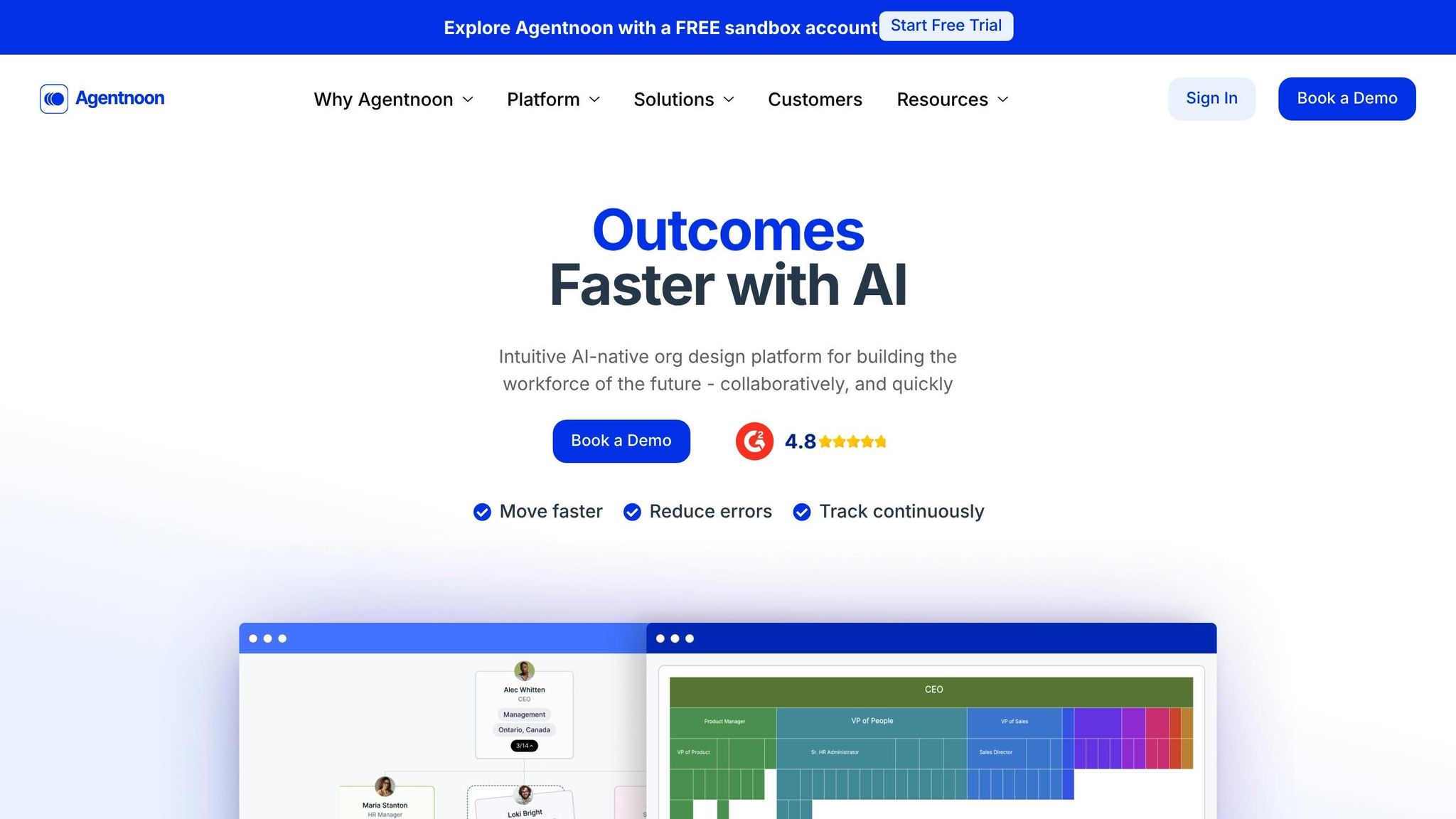
Agentnoon is a workforce planning platform tailored for growing SMBs. Unlike traditional HR tools that focus on daily operations, Agentnoon zeroes in on long-term strategies and data-backed insights to help businesses navigate workforce challenges effectively.
Designed for companies with 50–500 employees, Agentnoon is ideal for SMBs looking to go beyond basic scheduling and tackle hiring, resource allocation, and organizational planning with precision.
Workforce Forecasting
One of Agentnoon’s standout features is its ability to forecast staffing needs using scenario planning and predictive modeling. Businesses can create multiple workforce scenarios based on growth projections, seasonal trends, or shifts in market conditions. For example, a company can model how an increase in revenue, changes in project timelines, or plans for expansion will affect staffing needs over the next 6 to 18 months.
The platform factors in critical elements like employee turnover rates, skill shortages, and departmental growth trends. Imagine a marketing agency expecting a 30% jump in client work during Q4. Agentnoon can calculate exactly how many additional designers, account managers, or project coordinators they’ll need, along with the ideal timeline for those hires.
It doesn’t stop at headcount. The system also accounts for the full cost of hiring - recruitment, onboarding, and even the temporary drop in productivity as new employees ramp up. This gives SMBs a clear picture of their workforce investment, far beyond just salary numbers.
Integration Capabilities
Agentnoon seamlessly connects with popular tools like BambooHR, Gusto, Slack, and applicant tracking systems, ensuring smooth data flow without the hassle of manual entry. It also integrates with financial tools such as QuickBooks and Xero, aligning workforce planning with budget and revenue forecasts.
For SMBs needing to justify hiring plans to investors or board members, these integrations make it easy to back decisions with solid financial data. Additionally, the platform’s API allows for custom integrations, adapting to specific workflows and unique business needs.
Analytics and Reporting
Agentnoon’s analytics go beyond the basics, offering insights into workforce efficiency, cost per hire, time-to-productivity for new employees, and departmental growth trends. Reports are fully customizable, so businesses can focus on the metrics that matter most to specific teams or roles.
The platform also includes predictive indicators that flag potential problems before they escalate. For example, if data suggests a department is at risk of losing key personnel, the system can recommend proactive steps like hiring or retention strategies.
Its visual tools make it easy to connect workforce investments to business outcomes, helping managers secure buy-in for hiring plans by clearly showing the return on investment.
Scalability
Agentnoon is built to grow alongside your business. Its modular design allows companies to start with basic features and expand into more advanced capabilities as their needs evolve.
The pricing adapts based on employee count and feature usage, making it an accessible option for smaller businesses while providing room to scale. This eliminates the need to switch platforms as the company grows, avoiding the headaches of data migration and system disruptions.
For SMBs expanding across multiple locations or states, Agentnoon’s ability to handle complex organizational structures and varying labor laws is a game-changer. Whether managing growth in one state or several, the platform ensures workforce planning remains smooth and efficient.
2. BambooHR

BambooHR combines essential HR management tools with workforce planning features, offering a practical solution for small and medium-sized businesses. Originally built as a core HR platform, it now supports both day-to-day HR operations and strategic workforce planning, making it a versatile choice for growing companies.
Workforce Forecasting
The People Analytics module in BambooHR helps managers anticipate future hiring needs by analyzing historical staffing data. It simplifies headcount planning, allowing businesses to create hiring strategies that align with their budgets and broader business goals.
Integration Capabilities
BambooHR works seamlessly with a range of popular business tools. It integrates with payroll providers, project management software, and accounting platforms. Additionally, its open API allows businesses to develop custom integrations tailored to their unique needs.
Analytics and Reporting
BambooHR offers powerful reporting tools that turn data into actionable insights. With access to pre-built reports and customizable reporting options, users can track key HR metrics like hiring progress and employee engagement. Real-time dashboards ensure that critical information is always at your fingertips.
Scalability
Thanks to its modular design, BambooHR grows alongside your business. Companies can start with core HR features and add workforce planning tools as their needs evolve. Features like role-based permissions and easy data migration make it simple to manage teams across multiple locations and adapt to organizational changes.
3. Rippling
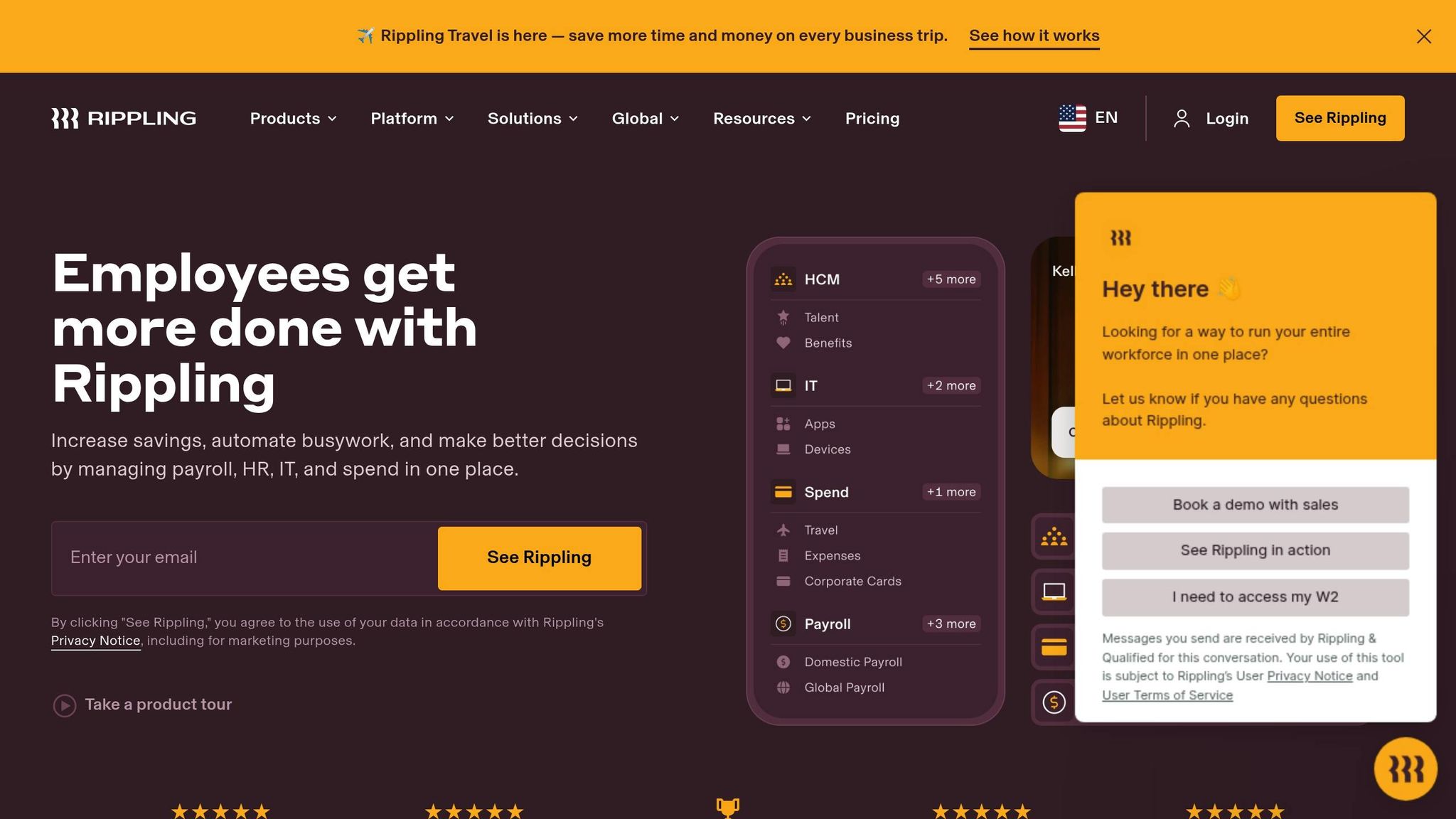
Rippling brings together HR, IT, and finance into a single platform, making it a go-to solution for small and medium-sized businesses (SMBs) looking to streamline workforce planning. By integrating these key functions, Rippling simplifies staffing and cost management, helping businesses operate more efficiently.
Workforce Forecasting
Rippling provides tools for headcount planning that allow businesses to forecast staffing needs based on budget constraints and growth goals. Managers can craft hiring plans tailored to specific departments, roles, or schedules, ensuring that workforce growth aligns with broader business objectives.
What sets Rippling apart is its ability to calculate the total cost of each potential hire. This includes not just salaries but also benefits, taxes, and even equipment expenses. Having this big-picture view helps SMBs decide where and when to invest in new talent, avoiding budget pitfalls that can hit smaller businesses particularly hard.
Integration Capabilities
Rippling combines essential business functions - like payroll, benefits management, device oversight, and app provisioning - into one cohesive system, reducing reliance on multiple third-party tools.
For businesses that do require external software, Rippling integrates seamlessly with popular platforms such as QuickBooks, NetSuite, Slack, and Google Workspace. Thanks to its unified data model, employee information flows automatically across connected systems, eliminating the need for repetitive manual data entry.
Analytics and Reporting
Rippling’s real-time dashboards provide customizable insights into key metrics like headcount, turnover rates, and hiring speed. Managers can dive deep into specific departments or locations to uncover trends or address potential issues before they escalate. The platform also automates compliance reporting, generating critical documents for tax filings, benefits management, and regulatory needs.
Scalability
Rippling’s modular design allows businesses to add HR, IT, and finance tools as they grow. It’s built to handle multi-state and international operations, automatically adjusting for local tax codes, labor laws, and compliance requirements.
As businesses expand, Rippling’s role-based permissions and approval workflows scale alongside them. This ensures sensitive employee data stays secure while still giving managers the access they need for effective decision-making. Rippling’s adaptability ensures that workforce planning remains smooth and strategic, no matter how much a business evolves.
4. Drivetrain
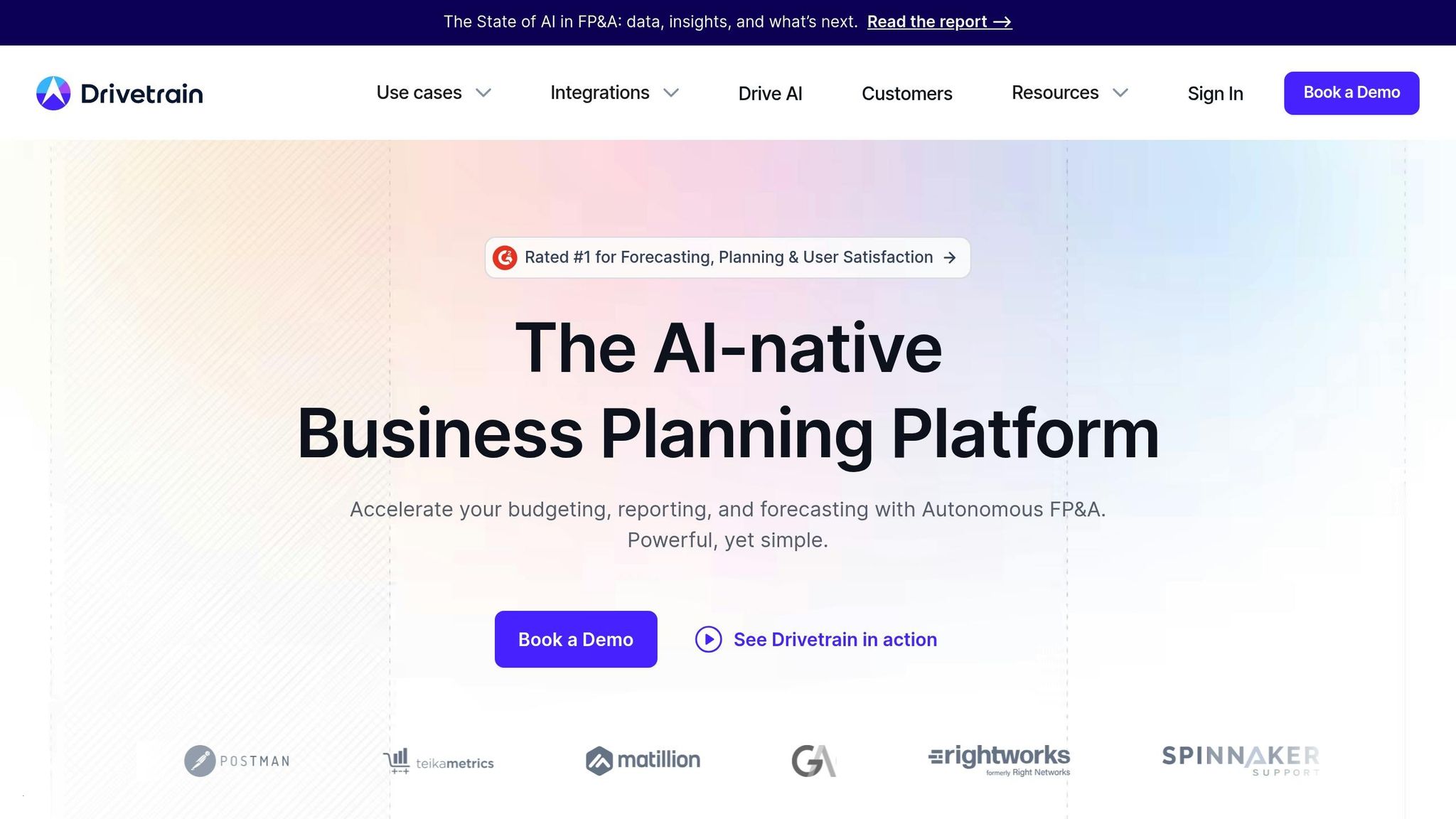
Drivetrain is a financial planning tool designed to help growing SMBs link workforce costs to revenue and profitability. It simplifies the process of understanding the financial outcomes of workforce-related decisions.
Workforce Forecasting
Drivetrain takes a financial-first approach to workforce forecasting, enabling businesses to analyze hiring scenarios and their effects on cash flow and profitability. By modeling headcount plans - including salaries, benefits, and time-to-productivity - it projects how workforce changes will influence revenue over the next year.
For example, if you're considering hiring three new sales representatives, Drivetrain can simulate how this decision might impact your sales pipeline, factoring in ramp-up periods and territory assignments. This level of detail provides SMB leaders with a clearer understanding of whether their workforce investments are likely to deliver returns on schedule.
The platform also excels in seasonal workforce planning, making it particularly useful for businesses with fluctuating demand. It allows you to model temporary staffing needs and assess their financial impact, ensuring your workforce strategy aligns with your financial goals.
Integration Capabilities
Drivetrain seamlessly integrates with tools like Salesforce, HubSpot, and QuickBooks, syncing sales and financial data with workforce models.
Its standout feature is the ability to automate data synchronization between financial and operational systems. For instance, when your sales team closes a deal in Salesforce, the revenue data automatically flows into Drivetrain’s workforce models. This integration helps you determine if your current staffing levels can support anticipated growth.
For SMBs juggling multiple systems, Drivetrain acts as a centralized hub, combining workforce costs, revenue forecasts, and operational metrics. This eliminates the need for time-consuming manual data compilation when making staffing decisions.
Analytics and Reporting
Drivetrain provides detailed reporting on metrics like cost per hire, revenue per employee, and ROI on workforce investments. Its visual dashboards make it easy to identify trends and pinpoint which roles or departments are delivering the best returns.
The platform also supports scenario planning, allowing users to compare workforce strategies side by side. For example, you can evaluate the financial impact of hiring two senior developers versus three junior developers, considering factors like training costs, productivity timelines, and retention rates.
Additionally, real-time budget tracking ensures you stay on target. Drivetrain alerts you if hiring plans risk exceeding budget limits and suggests alternative strategies that align with growth objectives while staying financially responsible.
Scalability
Drivetrain adapts as businesses grow, offering flexible, multi-location workforce modeling. Whether you’re expanding into new markets or launching additional product lines, the platform can model workforce needs for each division while maintaining an overarching view of the company.
It also manages multi-location workforce planning, automatically accounting for regional differences in salaries, taxes, and hiring costs. This feature is especially important for businesses scaling geographically, as it provides a clear picture of the true cost of building teams in various locations.
These scalable tools, paired with its financial insights, make Drivetrain a powerful ally for strategic workforce planning.
5. Homebase
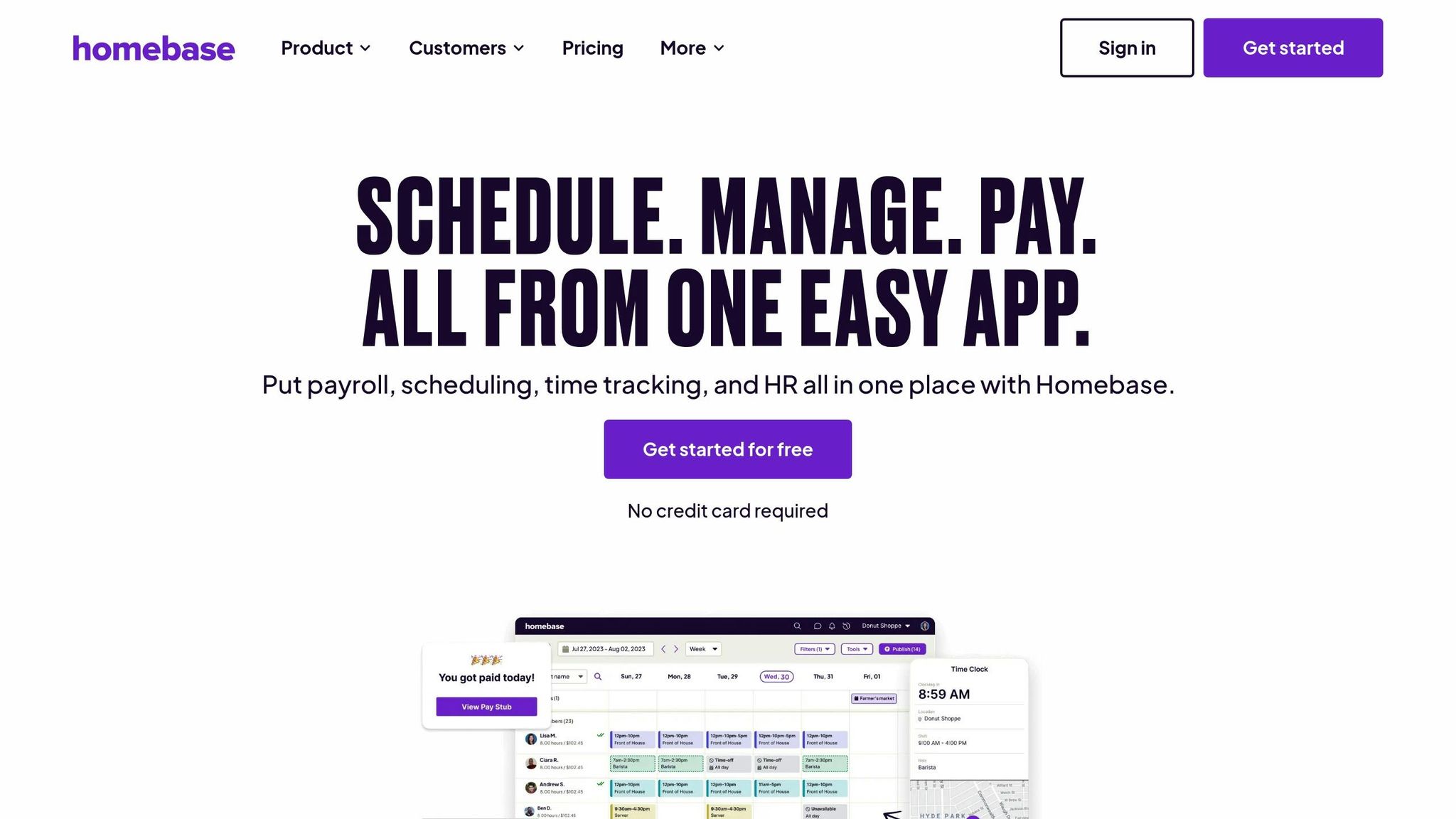
Homebase is tailored for small retail, restaurant, and service businesses. With over 100,000 small businesses across the United States relying on this platform, it simplifies employee scheduling and time tracking without requiring advanced technical skills.
Workforce Forecasting
Homebase offers automated scheduling tools that use historical data, employee availability, and projected business demand to predict staffing needs. This ensures managers can create schedules that align with expected customer traffic, reducing overstaffing or understaffing. For example, a small restaurant used Homebase to automate schedules and track labor costs by analyzing past sales and employee availability. The result? A 15% reduction in overtime expenses and better shift coverage during peak hours. These forecasting tools also integrate seamlessly with other systems to improve scheduling accuracy.
Integration Capabilities
The platform connects effortlessly with popular payroll, POS, and HR systems like QuickBooks, Square, and Gusto. These integrations allow for automatic data transfers, streamlining processes such as payroll, compliance, and scheduling. By centralizing these workflows, Homebase ties scheduling decisions directly to financial outcomes, making operations smoother and more efficient.
Analytics and Reporting
Homebase provides real-time dashboards and detailed reports on labor costs, attendance, and scheduling trends, empowering managers to make informed decisions. Weekly labor cost reports highlight patterns, such as shifts that consistently exceed budget, helping optimize future schedules. Additionally, built-in compliance tools monitor employee hours, breaks, and overtime to ensure labor law adherence, alerting managers to potential issues. The platform also tracks performance, enabling managers to identify top employees and assign shifts strategically.
Scalability
As your business grows, Homebase evolves with you. Whether expanding from one location to many, the platform simplifies managing schedules, time tracking, and labor analytics across multiple sites. It allows business owners to compare labor costs and productivity between locations while providing regional managers with site-specific data. Corporate leadership retains overall oversight, ensuring consistency. Even with multiple locations, Homebase keeps the setup and management process straightforward, making it an ideal solution for growing businesses.
6. 7shifts
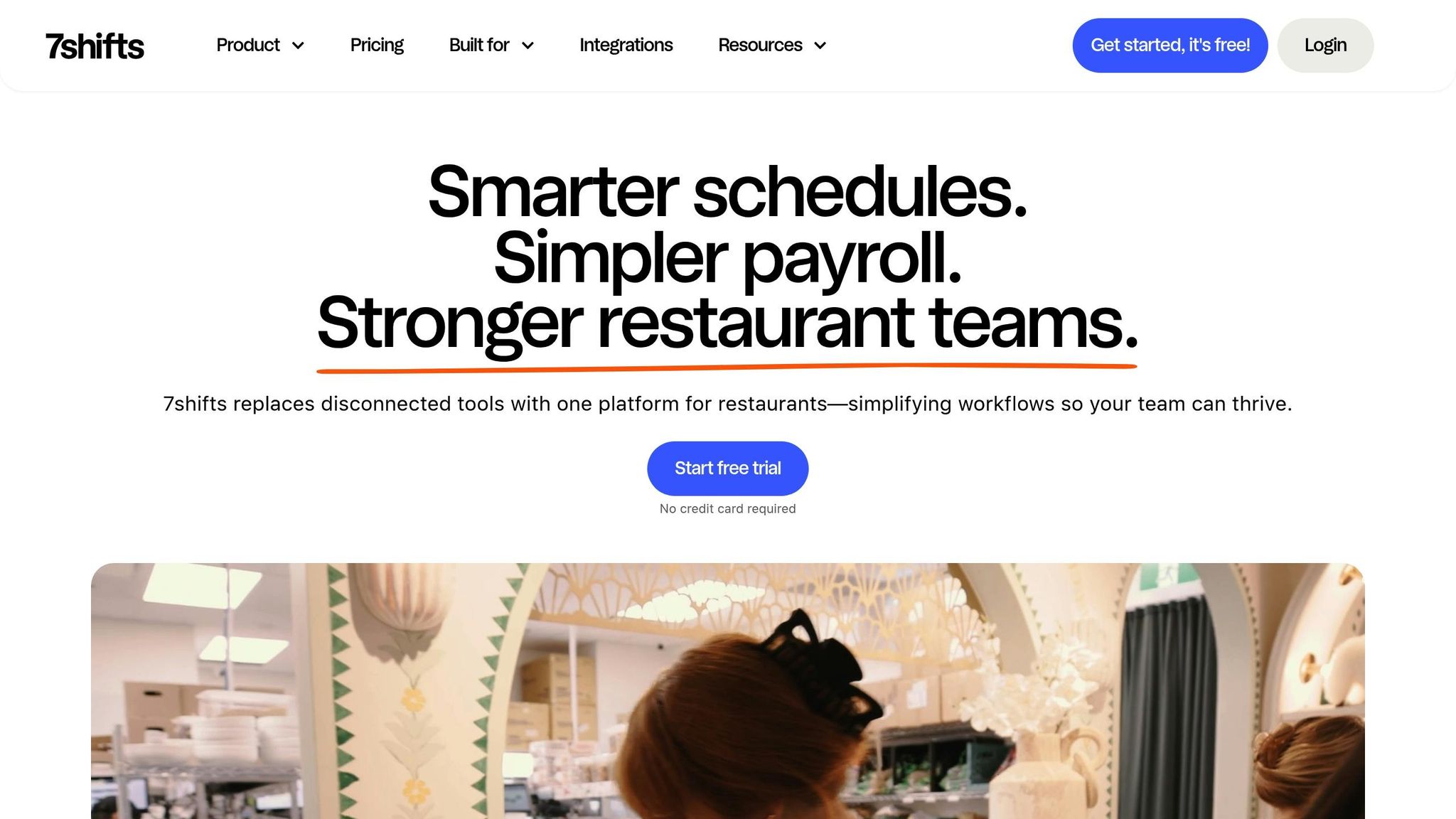
7shifts is a workforce management tool tailored specifically for restaurants, catering to over 40,000 establishments across North America. Its focus on the unique needs of food service businesses - balancing customer demand, labor costs, and complex scheduling - makes it a go-to solution for the industry.
Workforce Forecasting
7shifts employs advanced sales forecasting algorithms to help restaurants predict staffing needs with precision. By analyzing historical data, weather conditions, and local events, the system offers insights into optimal staffing levels. Managers can input anticipated sales figures, and the software calculates the best staffing mix based on labor cost targets, skill requirements, and patterns like day-of-week trends or seasonal fluctuations. For instance, it might recommend additional kitchen staff on a Friday night, when sales typically spike by 30% compared to weekdays. These recommendations are further refined through integrations with other essential systems.
Integration Capabilities
The platform integrates with over 30 point-of-sale systems like Toast, Square, Clover, and Lightspeed, automatically pulling sales data to enhance labor forecasts. Payroll integrations with tools such as ADP, Paychex, and QuickBooks simplify the process of moving from scheduling to payroll. Communication is also streamlined with features like direct messaging for staff updates and integrations with platforms like Slack and Microsoft Teams, ensuring managers and employees stay connected.
Analytics and Reporting
7shifts provides real-time labor cost tracking, sending alerts when costs exceed budget limits. Managers can take immediate action, such as reducing staff during slower periods or adding coverage during busy times. The software also delivers detailed performance analytics, tracking employee productivity, attendance, and compliance with labor laws. Weekly reports highlight key trends, such as shifts that consistently go over budget or employees with frequent no-shows. Additionally, the system monitors break compliance and overtime to help avoid labor violations. These tools make it easier to identify inefficiencies and maintain compliance while scaling operations.
Scalability
Designed to grow with restaurant groups, 7shifts offers centralized management for multiple locations while allowing individual restaurants to retain flexibility in scheduling. Corporate managers can compare labor data across locations, while assistant managers handle day-to-day scheduling tasks. Role-based permissions ensure that responsibilities are appropriately distributed, and the system adapts to local labor regulations as businesses expand. All of this happens without the need for a complete system overhaul, making 7shifts a reliable choice for growing operations.
7. Paymo
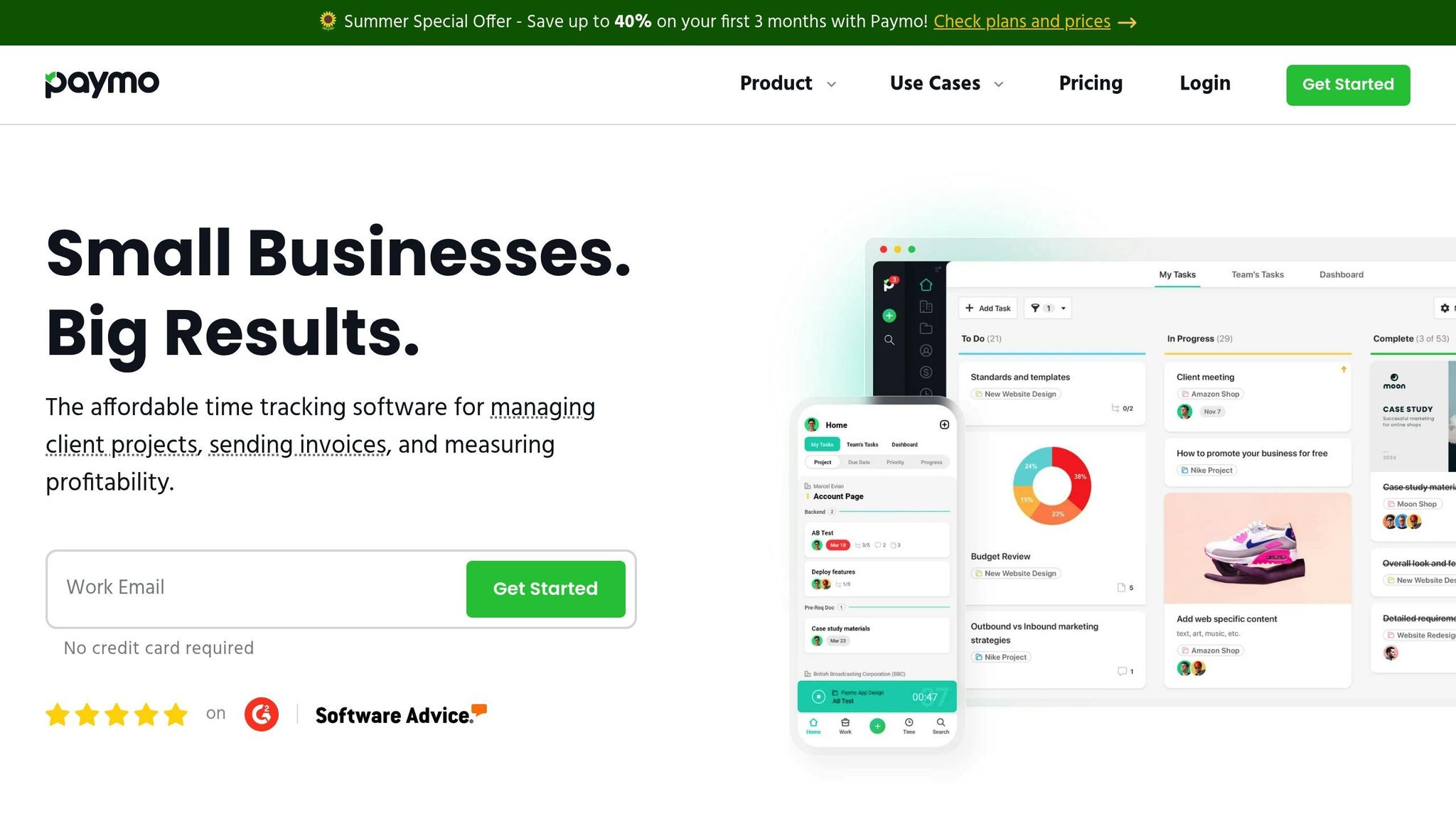
Paymo is a project management platform tailored for small and medium-sized businesses (SMBs), offering a blend of project tracking, time management, and resource allocation tools. Initially built with creative agencies and professional services in mind, Paymo has grown into a versatile solution for managing workforce planning and human resources.
Workforce Forecasting
At the heart of Paymo's workforce planning is its Team Schedule feature, which uses interactive Gantt charts and calendar views for visual resource management. By analyzing historical project data and team performance metrics, the platform helps managers anticipate staffing needs and allocate resources effectively.
When planning a project, Paymo calculates required hours based on past data and suggests assignments that align with team members' skills, availability, and workload. It also monitors team utilization, flagging when employees are overbooked or underutilized. This helps businesses make smarter decisions about hiring, project timelines, and resource distribution. Over time, Paymo becomes more accurate in forecasting by learning from completed projects and comparing actual time spent to initial estimates.
Integration Capabilities
Paymo integrates with over 30 popular business tools, making it easy to incorporate into existing workflows. These integrations enhance its functionality and forecasting precision. For example:
- Accounting software: Connect with QuickBooks and Xero for invoicing and financial tracking.
- Communication tools: Sync with Slack and Microsoft Teams so team members can log time and update project statuses directly within their preferred platforms.
- CRM platforms: Link with HubSpot and Pipedrive to automatically create projects from sales opportunities and track the customer journey from lead to project completion.
- Cloud storage: Use Google Drive, Dropbox, or OneDrive for centralized file management.
These integrations streamline operations, ensuring that teams can work efficiently without switching between multiple systems.
Analytics and Reporting
Paymo provides detailed analytics through customizable reports and real-time dashboards. Managers can monitor key metrics like billable hours, project profitability, and team productivity over specific timeframes.
The platform also tracks employee performance, highlighting which team members consistently meet deadlines and deliver quality results. Budget tracking is a standout feature, offering clear comparisons between actual and estimated costs for both projects and individual team members. Automatic timesheets and time allocation insights help identify inefficiencies and bottlenecks. To keep everyone in the loop, Paymo can automate weekly or monthly reports and send them directly to stakeholders.
Scalability
Paymo is designed to grow alongside small businesses. It supports unlimited projects and clients, with pricing that adjusts based on team size. As businesses expand, they can add team members and customize permission levels, ranging from basic time tracking to full administrative control.
The platform also accommodates complex organizational needs with project templates and custom workflows. This allows businesses to standardize processes as they scale. For those with advanced requirements, Paymo's API supports custom integrations and automation, making it a flexible choice for evolving operational demands.
sbb-itb-ef0082b
8. Teamhood
Teamhood brings project management and workforce planning together by consolidating key business tools into a single, user-friendly workspace. This setup makes it easier for teams to collaborate across different platforms.
Integration Capabilities
Teamhood connects seamlessly with tools like Microsoft Teams, Slack, Google Calendar, and Microsoft Outlook. These integrations enable notifications, task creation, and schedule coordination, keeping teams aligned. For development workflows, the Azure DevOps integration offers bidirectional synchronization, allowing teams to stick with their familiar processes while working within Teamhood's platform.
"Bring your entire toolset and team into one intuitive workspace. Integrate with a few clicks to simplify cross-functional collaboration and bring teams together"
Through Zapier, Teamhood can link with over 3,500 apps, automating workflows and cutting down on repetitive tasks.
"Use Zapier middleware to connect almost any software to Teamhood."
For businesses needing more tailored solutions, Teamhood provides custom integrations via its Open API. It also supports advanced identity management features like Single Sign-On (SSO) and SCIM, making it easier for organizations to scale their connectivity as they grow. This extensive integration capability ensures projects, communication, and task management stay perfectly aligned.
9. tamigo
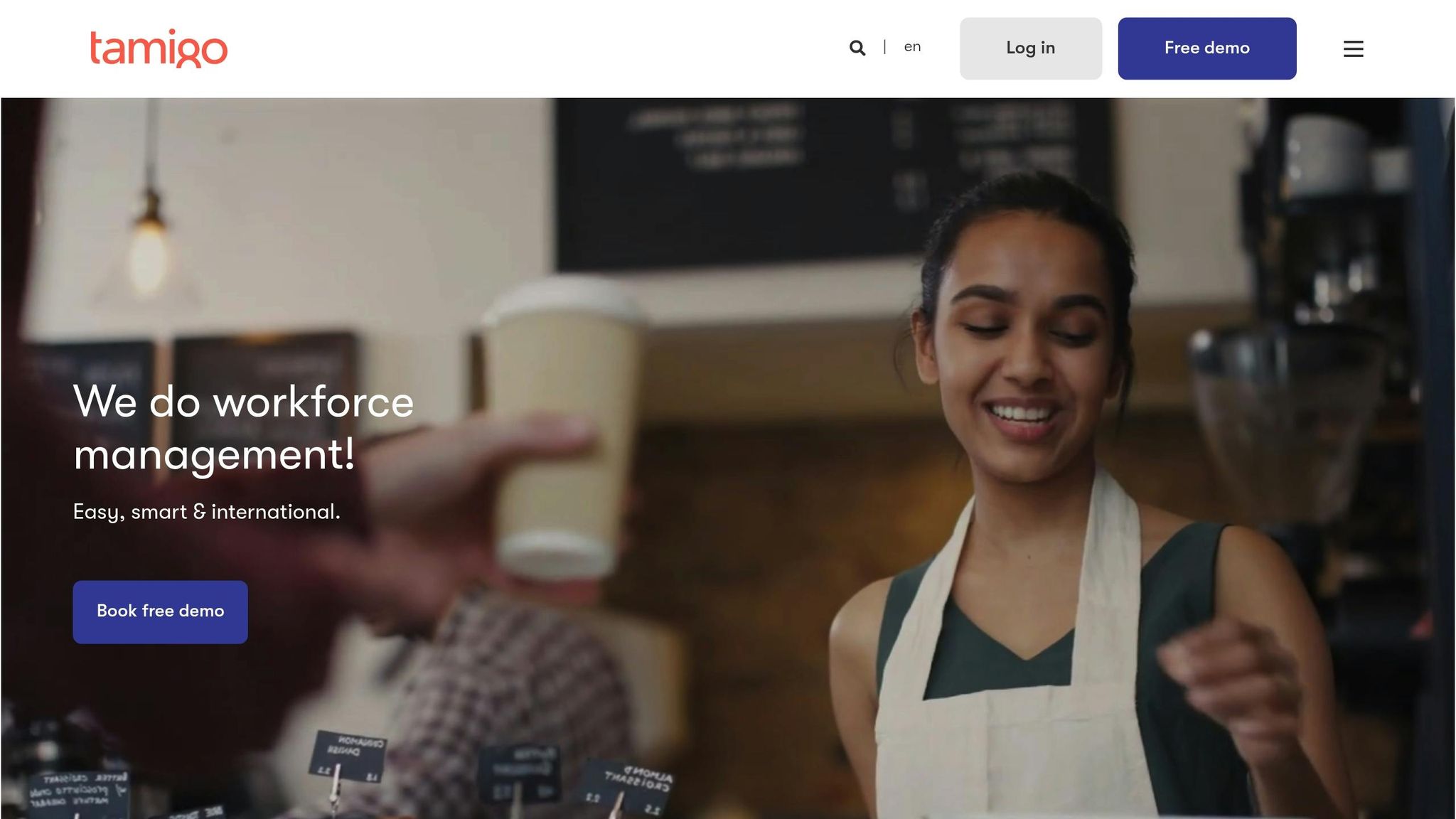
tamigo is a workforce planning tool tailored for small and medium-sized businesses (SMBs). Instead of requiring businesses to adopt entirely new systems, tamigo works as a central hub, connecting seamlessly with the tools they already rely on.
Integration Capabilities
With its open API, tamigo integrates effortlessly with a variety of essential business software, including HR management systems, payroll platforms, and point-of-sale tools. This integration ensures businesses can keep their existing systems while streamlining workforce planning. By automating workflows, centralizing employee data, and syncing updates across platforms, tamigo reduces manual data entry and the errors that often come with it. This approach creates a smooth, connected experience for managing workforce operations.
Scalability
tamigo is designed to grow with your business. Its architecture supports international needs and adapts to expanding IT infrastructures without requiring a complete system overhaul. Businesses can start small and gradually expand their use of tamigo as they grow, avoiding disruptions to daily operations. This flexibility helps SMBs improve workforce planning while keeping costs and complexities in check.
10. ChartHop
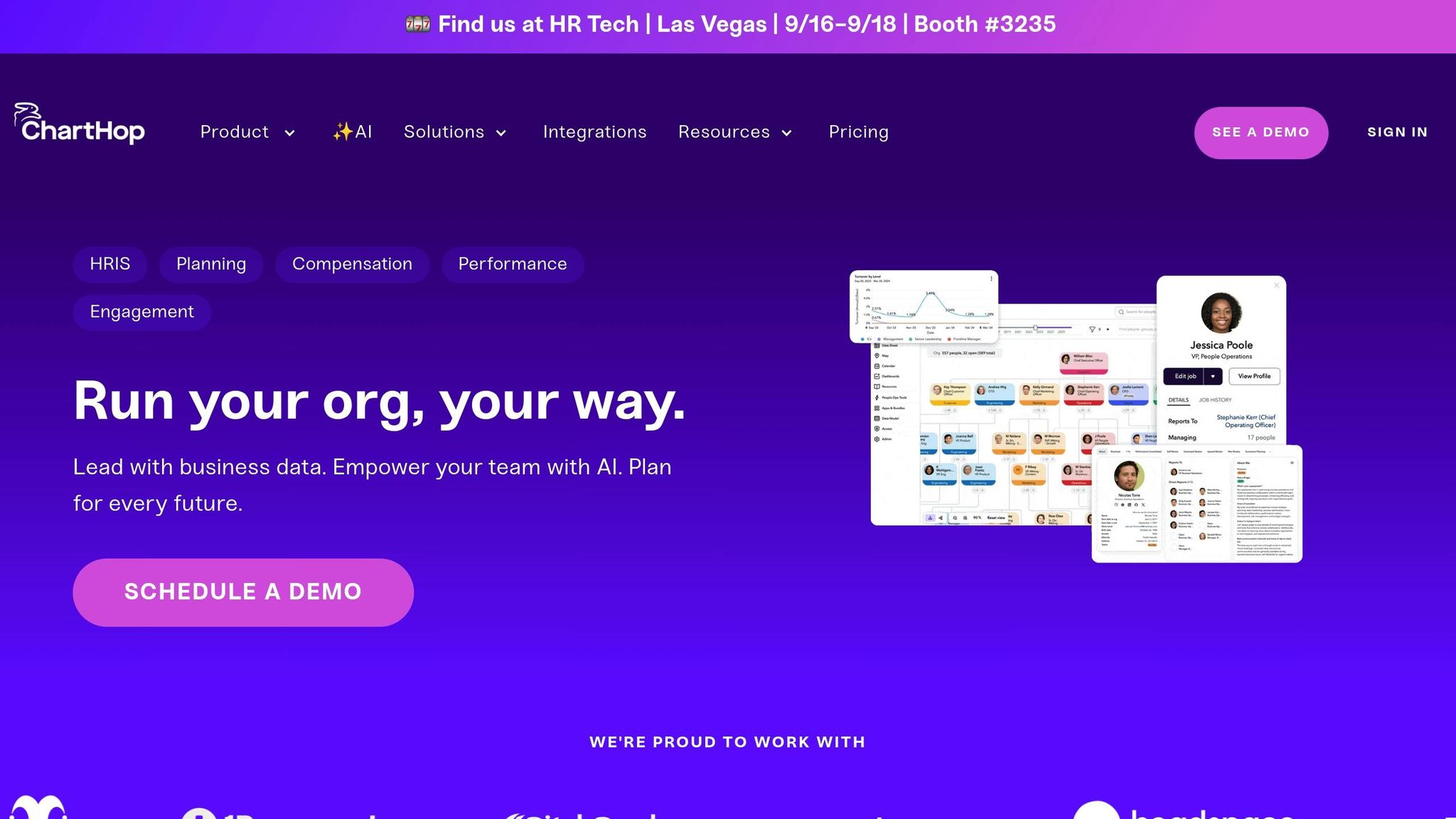
ChartHop provides a platform designed to simplify workforce planning for small and medium-sized businesses (SMBs). By combining organizational charts with strategic planning tools, it helps companies visualize their current team structure and prepare for future growth.
Workforce Forecasting
With ChartHop, managers can simulate the impact of hiring, promotions, or restructuring on budgets and team dynamics. It creates a balance between ambitious growth plans and budgetary limitations.
The platform tracks essential metrics like headcount, turnover, and compensation. This data enables business owners to predict staffing needs based on revenue goals or seasonal fluctuations. These forecasts seamlessly integrate with existing financial and HR systems, streamlining operations.
Integration Capabilities
ChartHop integrates with widely used HRIS systems, payroll platforms, and performance management tools, consolidating workforce data into one accessible hub.
Additionally, it connects with financial planning tools, ensuring workforce expenses align with broader budget planning. Since personnel costs are often the largest expense for growing companies, this integration ensures financial forecasts remain accurate and actionable.
Analytics and Reporting
ChartHop transforms complex workforce data into easy-to-read dashboards filled with charts and graphs. This allows SMB leaders to spot hiring trends, retention patterns, and team performance metrics without needing advanced analytical skills.
The platform’s reports include diversity and inclusion metrics, compensation breakdowns, and overall organizational health indicators. These insights empower business owners to address pay equity, optimize team composition, and allocate resources effectively. The visual reports are also easy to share with stakeholders, making them a valuable tool for strategic discussions.
Scalability
ChartHop is built to grow alongside your business. Whether you’re expanding your team, adding departments, or reorganizing operations, the platform adapts to accommodate these changes while ensuring data remains accurate.
Its pricing model adjusts based on company size, making it an affordable option for smaller teams while offering advanced features for businesses as they scale. This flexibility allows organizations to start with essential tools and expand their capabilities as their needs evolve.
Software Comparison: Pros and Cons
Selecting the best workforce planning software for your small business hinges on your specific needs - whether that's tied to your company's size, industry, or how you operate day-to-day. Here's a breakdown of some recurring themes we noticed in the platform reviews:
- Forecasting Tools: Options range from simple headcount planning to more complex tools for modeling different scenarios.
- Integration Options: Some platforms boast extensive app networks, while others stick to basic, streamlined connectors.
- Reporting Features: You’ll find everything from real-time dashboards packed with analytics to quick, no-frills reports.
- Scalability: Certain systems are built to handle rapid growth, while others are better suited for smaller organizations that might eventually outgrow the software.
- Ease of Use and Support: User adoption, customer support, and built-in compliance tools can vary widely from one platform to another.
Ultimately, the ideal software will fit your current workflows, align with your budget, and have the flexibility to grow alongside your business.
Conclusion
Choosing the right workforce planning software for your small or medium-sized business comes down to aligning the platform’s features with your specific needs. Different tools cater to varying business models and stages of growth, so understanding your priorities is key.
Start by addressing your most pressing challenges. For example, if shift scheduling and managing employee availability are your main concerns, platforms like 7shifts or Homebase - geared toward industries like hospitality - might be ideal. On the other hand, if you need a more robust solution that combines workforce planning with HR management, tools such as BambooHR or Rippling could be a better fit. For companies focused on financial forecasting and scenario planning, Drivetrain offers specialized capabilities.
Budget is another critical factor. Many software options come with tiered pricing plans that scale with your team size, but be mindful of the features included at each level. Beyond the monthly subscription, consider hidden costs like implementation, training, and integration, as these can add up quickly.
Your growth plans should also influence your decision. If you expect to double your workforce in the next couple of years, opt for a platform that can grow with you. Avoid paying for enterprise-level features you don’t need right now, but ensure the system won’t limit you as you expand.
Integration with your existing systems is equally important. A tool that works seamlessly with your current setup will enhance efficiency and help maintain compliance, as discussed earlier.
Finally, take advantage of free trials or entry-level plans to test how the software fits into your daily operations. The right platform should save you time, reduce scheduling headaches, and provide actionable insights that help you make smarter hiring decisions as your business scales. By focusing on cost, scalability, and integration, you’ll be better equipped to tackle operational challenges and set your business up for long-term success.
FAQs
What should I look for in workforce planning software for my small business?
When selecting workforce planning software for your small business, prioritize tools that include key features like employee scheduling, labor cost management, and compliance tracking. These functionalities are crucial for keeping your operations organized and efficient. Additionally, make sure the software works smoothly with your current systems and is easy for you and your team to use.
Think about what you want to achieve - whether it’s boosting efficiency, handling an increasing workload, or cutting down on labor costs. Matching the software’s features to your business objectives can help you simplify day-to-day tasks while setting the stage for future growth.
How do integrations improve the performance of workforce planning software for small businesses?
Why Integration Capabilities Matter for Workforce Planning Software
Integration capabilities can transform how small businesses use workforce planning software. When these tools connect with systems like payroll software, HRIS, or talent management platforms, they eliminate tedious manual data entry and enable smooth data sharing across different systems.
This connection allows businesses to tap into real-time insights, leading to more accurate workforce forecasting. With better data flow, companies can make quicker, well-informed decisions. The outcome? Improved efficiency, fewer errors, and the ability to adapt more easily to changing workforce demands.
What additional costs should small businesses consider when implementing workforce planning software?
When choosing workforce planning software, small businesses need to think beyond just the subscription fee. There are often extra costs to factor in, such as training expenses, customization or upgrade fees, and charges for adding extra users or contractors. These costs can differ based on how extensive the implementation is and the unique requirements of your business.
On top of that, poor workforce planning can lead to hidden expenses like unexpected overtime, lower productivity, or even employee turnover. By investing in the right software, you can reduce these risks, streamline your operations, and achieve long-term savings through better efficiency.
Summarize with AI
Related Posts
Best AI Skill Mapping Workforce Planning Solutions for 2025
Explore the top AI tools revolutionizing skill mapping for SMBs, enhancing workforce management and strategic hiring.
Cost-Effective Business Workflow Software
Explore cost-effective workflow software solutions for small business success. Learn about key features, best tools, open source options, and case studies.
Top 7 Tools for Predictive Succession Planning
Explore top AI-powered tools for predictive succession planning that enhance leadership transitions and talent management in organizations.
7 AI-Powered Talent Demand Forecasting Tools for HR
Explore 7 AI-powered talent demand forecasting tools for HR, learn about their key features, and understand how AI is transforming workforce planning and management.
